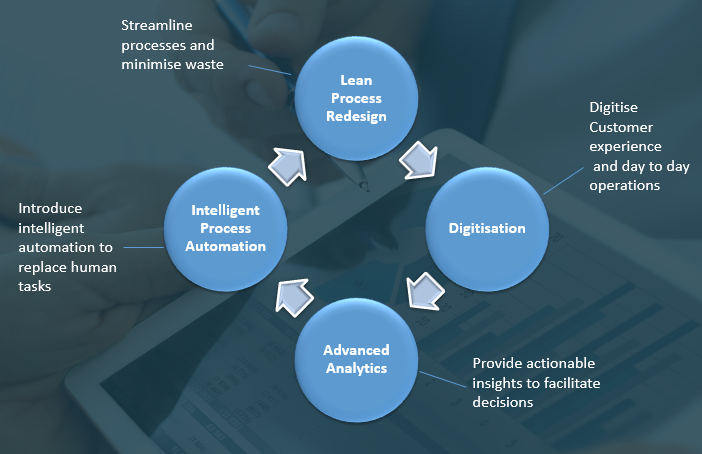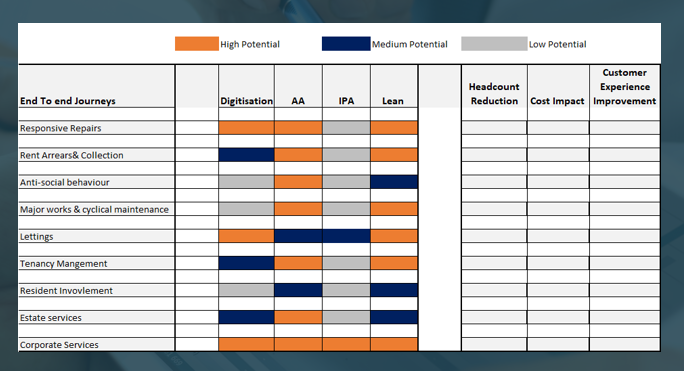- 4 June 2018
- Posted by: Peter Lunio
- Categories: Analytics, Artificial Intelligence, Digital, Lean Systems, Operating Model, social housing, value for money
Data from the Office for National Statistics’ 2016 bulletin ‘Internet Access – Households and Individuals’ showed that 82% of people in Great Britain used the internet daily or almost daily, an increase of 47% over the past decade. In England alone, 2.5 million of these households are housing association homes, according to the Department for Communities and Local Government’s (DCLG) April 2017 Housing Statistical Release. By 2020, the Government’s Digital Inclusion Strategy aims to have 90% of the UK population accessing the internet.
The sector continues to face increased pressure to deliver Value for Money services and delight customers. A prime strategy to enable this improved efficiency is via a digital shift, reinventing the operating model to capitalise on the recent trends in digitisation, analytics, and automation.
Registered Providers (RPs) know where they want to go. They want to be more agile, quicker to react, and more effective. They want to deliver great customer experiences, take advantage of new technologies to cut costs, improve quality and transparency, and build social value.
To date we have seen that many RPs are trying to get better, however the results tend to fall short: one-off initiatives in separate departments that don’t have a big organisation-wide impact; adoption of the ‘improvement’ method of the day, which almost invariably yields disappointing results; and programs that provide temporary gains but aren’t sustainable.
We have found that for RPs to build social value and provide compelling customer experiences at lower cost, they need to commit to the next-generation operating model. This operating model is a new way of running the organisation to combine digital technologies and operational capabilities in an integrated, well-sequenced way to achieve step-change improvements in income, customer experience, and cost.”
Thinking holistically achieves the operating model
Implementing a new operating model is best achieved through thinking holistically about how operations can contribute to delivering a distinctive customer experience. The best way to do this is to focus on customer journeys and the internal processes that support them. These naturally cut across organisational units, for example; housing management, operations, and finance operations to support a new customer taking on a home to rent.
Fig 1: Four approaches to drive the next-generation operating model
Organisations typically use four key capabilities or approaches ( See figure 1)
• Digitisation is the process of using tools and technology to improve journeys. Digital tools have the capacity to transform customer-facing journeys in powerful ways, often by creating the potential for self-service.
• Advanced Analytics (AA) is the autonomous processing of data using sophisticated tools to discover insights and make recommendations. It provides intelligence to improve decision making. For example, associations with the right data and capabilities in place are accelerating processes in areas such as rent arrears, repair & maintenance etc.
• Intelligent process automation (IPA) or digital assistants is an emerging set of new technologies that combine fundamental process redesign with robotic process automation and machine learning. IPA can replace human effort in processes that involve aggregating data from multiple systems or taking a piece of information from a written document and entering it as a standardised data input.
• Lean process redesign helps Associations streamline processes, eliminate waste, and foster a culture of continuous improvement. This versatile methodology applies well to short-cycle as well as long-cycle processes, transactional as well as judgment-based processes, customer-facing as well as internal processes.
Guidelines for implementing these approaches
Three design guidelines are crucial:
1. Organisations need to ensure that each approach is used to maximum effect. For example, in the case of analytics, utilising sophisticated modeling techniques and data sources in a concerted, cross-functional effort, while also ensuring that front-line employees execute a top-flight way on the insights generated by the models to give the maximum impact.
2. Implementing each lever in the right sequence. The best results come when the approaches can build on each other. That means, in practice, figuring out which one depends on the successful implementation of another and evaluating the potential impact of each approach on costs and customer experience.
3. Ensuring the approaches interact with each other to provide a multiplier effect. End-to-end journey “heat maps” provide a company-wide perspective on the potential impact and scale of the opportunity for each approach (see Fig 2). This is a valuable way to engage the leadership team in discussions around strategy and priorities.
Fig 2: The heat map provides a typical RP-wide integrated perspective of the potential for impact for each end-to-end journey.
’
In conclusion, transformation cannot be a departmental effort. The full impact of the next-generation operating model comes from combining operational-improvement efforts around customer-facing and internal journeys with the integrated use of approaches and capabilities.
© 2018 IwP All Rights Reserved
Error: Contact form not found.



